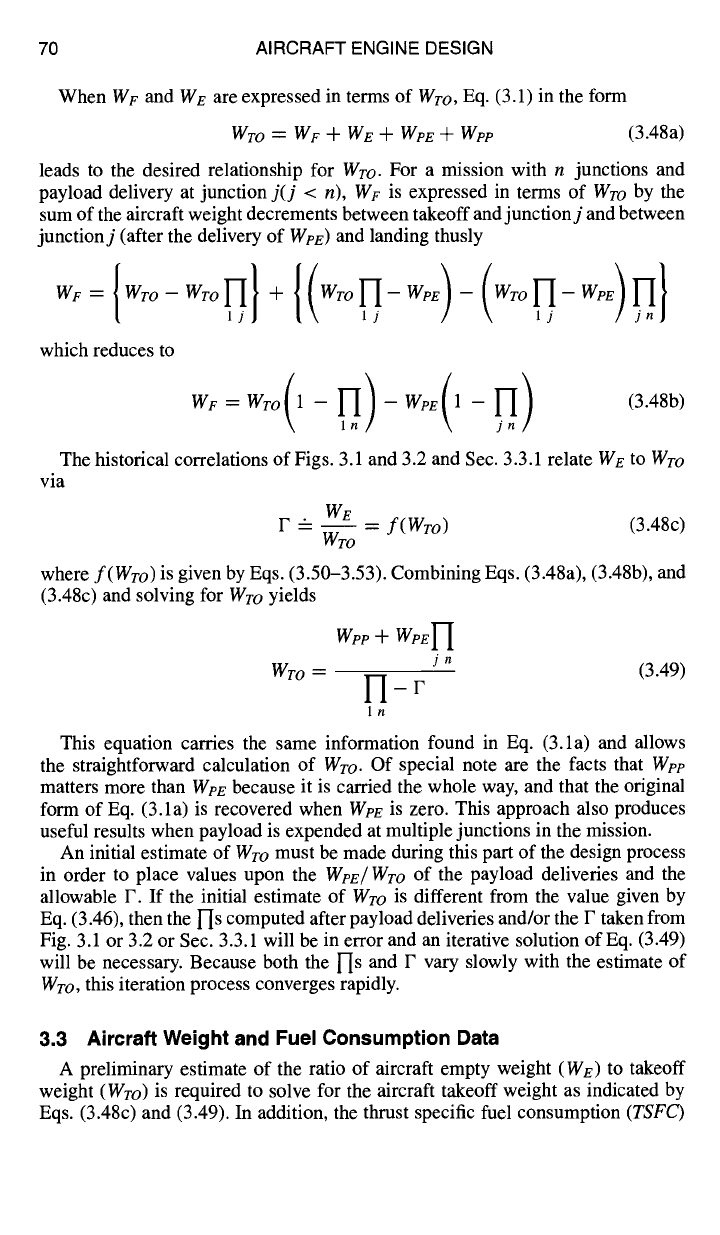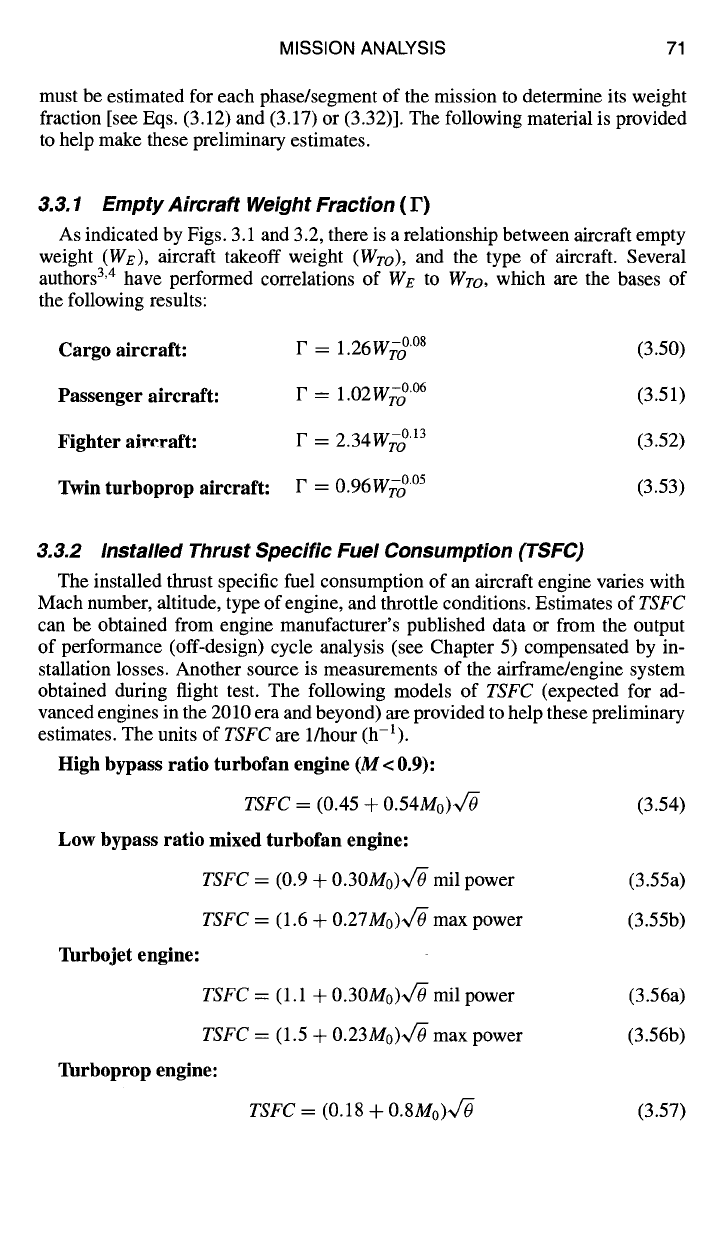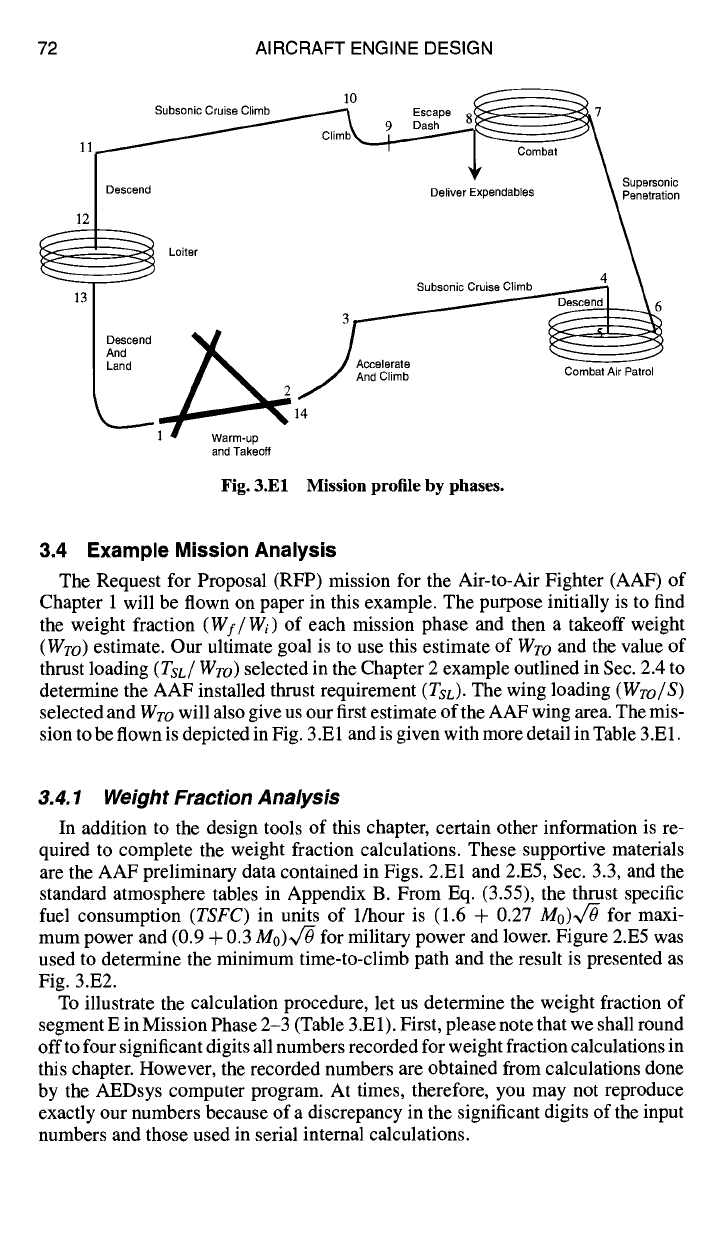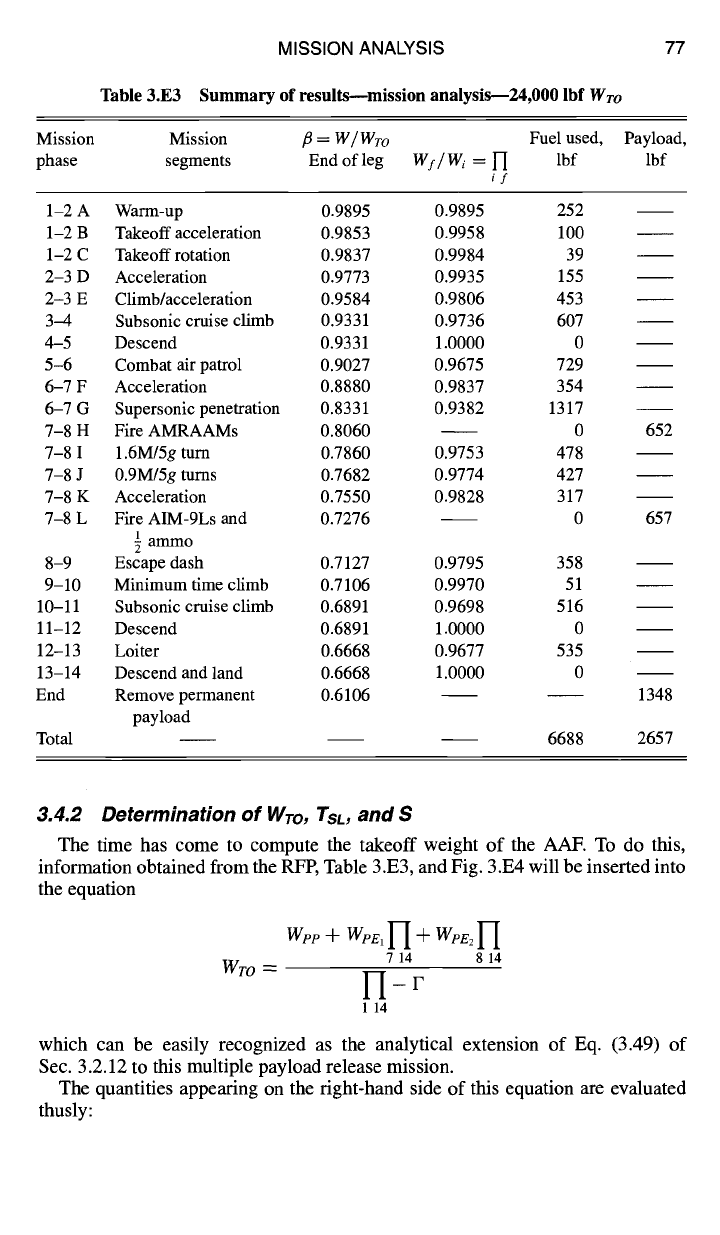Mattingly J.D., Heiser W.H., Pratt D.T. Aircraft Engine Design
Подождите немного. Документ загружается.


70 AIRCRAFT ENGINE DESIGN
When WF and We are expressed in terms of Wro, Eq. (3.1) in the form
Wro = We + WE + Wpe + Wpp (3.48a)
leads to the desired relationship for Wro. For a mission with n junctions and
payload delivery at junction j(j < n), WF is expressed in terms of Wro by the
sum of the aircraft weight decrements between takeoff and junctionj and between
junctionj (after the delivery of Wpe) and landing thusly
which reduces to
The historical correlations of Figs. 3.1 and 3.2 and Sec. 3.3.1 relate We to Wro
via
WE
F - -- -- f(Wro) (3.48c)
Wro
where f(Wro) is given by Eqs. (3.50-3.53). Combining Eqs. (3.48a), (3.48b), and
(3.48c) and solving for Wro yields
Wee + WPeI-- I
j n (3.49)
Wro
1---r
II
- F
In
This equation carries the same information found in Eq. (3.1a) and allows
the straightforward calculation of Wro. Of special note are the facts that Wpp
matters more than Wpe because it is carried the whole way, and that the original
form of Eq. (3.1a) is recovered when Wpe is zero. This approach also produces
useful results when payload is expended at multiple junctions in the mission.
An initial estimate of Wro must be made during this part of the design process
in order to place values upon the Wpe/Wro of the payload deliveries and the
allowable I'. If the initial estimate of Wro is different from the value given by
Eq. (3.46), then the I-I s computed after payload deliveries and/or the I" taken from
Fig. 3.1 or 3.2 or Sec. 3.3.1 will be in error and an iterative solution of Eq. (3.49)
will be necessary. Because both the l-I s and F vary slowly with the estimate of
Wro, this iteration process converges rapidly.
3.3 Aircraft Weight and Fuel Consumption Data
A preliminary estimate of the ratio of aircraft empty weight (WE) to takeoff
weight (Wro) is required to solve for the aircraft takeoff weight as indicated by
Eqs. (3.48c) and (3.49). In addition, the thrust specific fuel consumption (TSFC)

MISSION ANALYSIS 71
must be estimated for each phase/segment of the mission to determine its weight
fraction [see Eqs. (3.12) and (3.17) or (3.32)]. The following material is provided
to help make these preliminary estimates.
3.3.1 Empty Aircraft Weight Fraction (r)
As indicated by Figs. 3.1 and 3.2, there is a relationship between aircraft empty
weight (WE), aircraft takeoff weight (Wro), and the type of aircraft. Several
authors 3'4 have performed correlations of
We
to
Wro,
which are the bases of
the following results:
Cargo aircraft:
F : 1.26W~ -°'°8 (3.50)
Passenger aircraft:
F = 1.02
WTg "06
(3.51)
Fighter aircraft:
F = 2.34W~ -°'13 (3.52)
Twin
turboprop aircraft:
F = 0.96W~ -°'°5 (3.53)
3.3.2 Installed Thrust Specific Fuel Consumption (TSFC)
The installed thrust specific fuel consumption of an aircraft engine varies with
Mach number, altitude, type of engine, and throttle conditions. Estimates of
TSFC
can be obtained from engine manufacturer's published data or from the output
of performance (off-design) cycle analysis (see Chapter 5) compensated by in-
stallation losses. Another source is measurements of the airframe/engine system
obtained during flight test. The following models of
TSFC
(expected for ad-
vanced engines in the 2010 era and beyond) are provided to help these preliminary
estimates. The units of
TSFC are
1/hour (h-l).
High
bypass ratio
turbofan engine
(M < 0.9):
TSFC
= (0.45 + 0.54M0)v/-O (3.54)
Low bypass
ratio mixed turbofan engine:
TSFC
= (0.9 + 0.30M0)V'-0 mil power (3.55a)
TSFC
= (1.6 + 0.27M0)C'0 max power (3.55b)
Turbojet engine:
TSFC
= (1.1 + 0.30M0)~/-O mil power (3.56a)
TSFC
= (1.5 + 0.23M0)x/-0 max power (3.56b)
Turboprop engine:
TSFC
= (0.18 + 0.8M0)~¢/-0 (3.57)

72 AIRCRAFT ENGINE DESIGN
Subsonic Cruise Climb
~...~10 Escape ~ ~7
11 F -- ~ ~ Combat
D cen ~ Supersonic
12 P es d Deliver Expendables \ Spenetratio n
4
I Oesoen~ ~ I ~
I And ,~ I.
. . ~ ~J~
~.,.~ ~ "~ 14
and Takeoff
Fig. 3.E1 Mission profile by phases.
3.4 Example Mission Analysis
The Request for Proposal (RFP) mission for the Air-to-Air Fighter (AAF) of
Chapter 1 will be flown on paper in this example. The purpose initially is to find
the weight fraction
(Wf/Wi)
of each mission phase and then a takeoff weight
(Wro)
estimate. Our ultimate goal is to use this estimate of
Wro
and the value of
thrust loading
(TsL/Wro)
selected in the Chapter 2 example outlined in Sec. 2.4 to
determine the AAF installed thrust requirement (TsL). The wing loading
(WTo/S)
selected and
WTO
will also give us our first estimate of the AAF wing area. The mis-
sion to be flown is depicted in Fig. 3.El and is given with more detail in Table 3.El.
3.4.1 Weight Fraction Analysis
In addition to the design tools of this chapter, certain other information is re-
quired to complete the weight fraction calculations. These supportive materials
are the AAF preliminary data contained in Figs. 2.El and 2.E5, Sec. 3.3, and the
standard atmosphere tables in Appendix B. From Eq. (3.55), the thrust specific
fuel consumption
(TSFC)
in units of 1/hour is (1.6 + 0.27 M0)V'-O for maxi-
mum power and (0.9 + 0.3 M0)~/-ff for military power and lower. Figure 2.E5 was
used to determine the minimum time-to-climb path and the result is presented as
Fig. 3.E2.
To illustrate the calculation procedure, let us determine the weight fraction of
segment E in Mission Phase 2-3 (Table 3.El). First, please note that we shall round
off to four significant digits all numbers recorded for weight fraction calculations in
this chapter. However, the recorded numbers are obtained from calculations done
by the AEDsys computer program. At times, therefore, you may not reproduce
exactly our numbers because of a discrepancy in the significant digits of the input
numbers and those used in serial internal calculations.

MISSION ANALYSIS
Table 3.El AAF mission
73
Mission
phases Segments Condition
1-2 Warm-up and takeoff
A--Warm-up
B--Acceleration
C--Rotation
2-3 Acceleration and climb
D--Acceleration
E--Climb/acceleration
3-4 Subsonic cruise climb
4-5 Descend
5-6 Combat air patrol
6-7 Supersonic penetration
F--Acceleration
G--Penetration
7-8
8-9
Combat
H--Fire AMRAAMs
I--Tum 1
J--Turn 2
K--Acceleration
L--Fire AIM-9Ls & ½
ammo
Escape dash
9-10 Minimum time climb
10-11 Subsonic cruise climb
11-12 Descend
12-13 Loiter
13-14 Descend and land
2000 ft PA, 100°F
60 s, mil power
kro
= 1.2,
IZro
= 0.05, max power
Mro,
tR ---- 3 s, max power
Minimum time-to-climb path
Mro
to
McL/2000
ft PA, 100°F, mil power
Mcc/2000
ft PA, 100°F to
BCM/BCA,
mil power
BCM/BCA,
As23 + As34 = 150 n miles
BCM/BCA
to
Mcae/30k
ft
30 kft, 20 min
30,000 ft
McaP
to 1.5M/30k ft, max power
1.5M,
ASF
+ Asc = 100 n miles,
no afterburning
30,000 ft
652 lbf
1.6M, one 360 deg 5g sustained turn,
with afterburning
0.9M, two 360 deg 5g sustained turn,
with afterburning
0.8 to 1.6M, At < 50 s, max power
657 lbf
1.5M/30 kft, As89 = 25 n miles,
no afterburning
1.5M/30 kft to
BCM/BCA
BCM/BCA,
As10-11 = 150 n miles
BCM/BCA
to
Mloiter/lO kft
Mlo,er/10 kft, 20 min
Mloiter[lO
kft to 2000 ft PA, 100°F
One may question the wisdom of carrying calculations to four significant figures
that are based upon numbers often estimated to be correct to a few percent. The
underlying reason is that the 1--Is are generally the difference between unity and a
quantity of the order of 0.01, which is calculated from the estimated numbers--
often the exponents of Eqs. (3.14) and (3.16). Therefore, in order to be certain that
the small quantity is correct to two significant figures, it is necessary to maintain
four places in I-I. This should also be understood to emphasize the fact that the
weight fraction of fuel consumed (1 - l-I) for most flight legs is quite small, but
the cumulative effect is what matters.
During segment E, the AAF climbs and accelerates at military power to
BCM/
BCA
along the minimum time-to-climb path of Fig. 3.E2 via the following climb
schedule of Table 3.E2.

74 AIRCRAFT ENGINE DESIGN
70
60
50-
40-
Alt
_
30-
(kft) -
20-
10-
0
Ps (min = 0, max - 600, incr 50 fl/sec) Standard Day Atmosphere
t i i I i i I i t /
i i i l i i I I l i r I I I
100 500 1000 1500
Velocity (ft/sec)
Minimum time-to-climb path on
Ps
chart. Fig. 3.E2
lilt
2000
W/S = 64
- T/W = 1.25
_Beta = 0.97
g's = 1.00
Tmx = 1.0
- TR -
1.07
-AB off
_
Engine #2
Aircraft #5
-Min time
The mid state point is chosen arbitrarily but judiciously in order to obtain rea-
sonable average values. The reader, as ever, is free to vary the mid point selection
in order to determine the sensitivity of the results to this choice.
Equation (3.33) of Case 7, with CDR = 0, yields the
BCA
P 2~(Wro/S) ~/-~--,v
~BCA -- P--~td -- ~V ~DO/ ~1
}/rstd jr1 CRIT
where
Wro/S =
64 lbf/ft 2 and, from Fig. 2.Ela,
Mcmr=
0.9,
CDO
= 0.016,
and K1 = 0.18. From weight fraction calculations preceding segment E,
(fli)E
=
0.9773, which we can use as an estimate for fl = (fli)e so that
•BCA
=
0.1749 and h ~ 42,000 ft
Table 3.E2 Climb schedule
Altitude, ft Mach number Computation interval
2,000 (100°F) 0.70 Initial state point
9,000 0.775
16,000 0.85
23,000 0.875 Mid state point
30,000 0.90
36,000 0.90
42,000 0.90 Final state point

MISSION ANALYSIS 75
Proceeding, then, with the weight fraction calculation for segment E, we have
from Case 3, Eq. (3.20), with
CDR = 0
where
I-'Ie - Wf - exp (C1/M + C2) [ A(h + V2-/u 2g°) ] -1
c_ _(WTo3
u = cL o~ \YZs~J
For this illustrative calculation we select the single gross interval having the
initial, middle, and final state points listed with Table 3.E2. An appropriate average
value of u is found using fl =
fli
and values
CD/CL
and ot at the mid state point.
The initial, final, and middle state point values of h and M from Table 3.E2 and
fl = fli are
used in conjunction with the following Climb/Acceleration Weight
Fraction Calculation Method to find lie.
Climb/acceleration weight fraction calculation method
Given:
Initial state point quantities:
hi, M i , ( a / astd ) i , fl i
Final state point quantities:
h f, My, (a /asta) f
Middle state point quantities: h, M, 0, 8, 00, 80,
(a/asta), K1, K2, CDO
Other quantities:
astd, go, WTo/ S, y, Pstd, TSL/ WTO, Cl, C2
Equations:
Vi = (a /astd)iastdMi
Vf : (a/astd)fastdM f
\ 2g0 J 2go
o (W o3
U
TAs
AZ e
W 1-u
V = (a/aste)astaM
Ah = hi - h~ ,xt -- ~- V -d \-~s~ )
,,Ze= +,',(
,,, =
\ 2goJ
2~(Wro/ PstdSM 2 ]---[ {
CL -- l.e = exp
CD
K1 C2 't- K2CL q-
CDO
CL CL
If max power,
Ol = Olwet(O0, TR, 60)
(C1/M -[-
C2)
astd
x [A h -1 +

76 AIRCRAFT ENGINE DESIGN
If mil power,
With
ot = Otary(00,
TR, 30)
(a/astd)i
= 1.039
V/ = 811.7 ft/s
(a/asta)f
= 0.8671
Vf
= 870.9 ft/s
(AV2/2go)
= 1549 ft
Ah = 40,000 ft
AZe = 41,550ft
/3 = 0.9773
Wro/S
= 64 lbf/ft 2
3 = 0.4051
M = 0.88
CL = 0.1346
K1 = 0.18, K2 = 0.0
Coo
= 0.016
CD = 0.01926
CD/CL
= 0.1431
0 = 0.8420
00 = 0.9724
30 = 0.6706
Otary = 0.4024
TsL/WT'o
= 1.25
u = 0.2780
TAs/W
= 57,550ft
(a/astd)
= 0.9176
V = 901.2ft/s
At = 2.068 min
As = 18.39 n miles
Ct/M
+ C2 = 1.323h -1
then
FIE = 0.9812
This weight fraction of 0.9812 means that fuel in the amount (1 - 0.9812)
flWro
is consumed as 57,550 ft of weight specific thrust work is produced. The
dissipated nonmechanical energy fraction of this work is u = 0.2780, while the
fraction invested in airplane mechanical energy (Aze) is (1 -- u) = 0.7220, of
which 96.27% is potential energy and 3.72% is kinetic energy. The climb time and
ground distance covered are 2.068 min and 18.39 n miles, respectively.
At the end of segment
E,
/3f = /3t FIE =
0.9589. Now a new mean value of
/3 for segment E can be estimated and the calculation of Fie iterated. When this
is done using the average value of (0.9773 + 0.9589)/2 = 0.9681, we obtain the
same value for Fie, justifying the use of/3i for
~3avg.
Also the
8BCA
calculation can
be repeated now using/3f, and we find again that h ~ 42,000 ft.
This calculation illustrates how a mission leg weight fraction is determined. The
results of such calculations for all mission phases are contained in Table 3.E3 and
Fig. 3.E3. The detailed computations leading to the data shown there are given in
the Sec. 3.4.4 (Complete AAF Weight Fraction Computations).
--'[ = 0.7152
WF/WTo
= 0.2787
1 14
1-I = 0.8585 1-I = 0.9164
7 14 8 14

MISSION ANALYSIS
Table 3.E3 Summary of results---mission analysis---24,000 lbf WTO
77
Mission Mission fl =
W/Wro
Fuel used, Payload,
phase segments End of leg
I41[/Wi
= 1-I lbf lbf
if
1-2 A Warm-up 0.9895 0.9895 252
1-2 B Takeoff acceleration 0.9853 0.9958 100
1-2 C Takeoff rotation 0.9837 0.9984 39
2-3 D Acceleration 0.9773 0.9935 155
2-3 E Climb/acceleration 0.9584 0.9806 453
3--4 Subsonic cruise climb 0.9331 0.9736 607
4-5 Descend 0.9331 1.0000 0
5-6 Combat air patrol 0.9027 0.9675 729
6-7 F Acceleration 0.8880 0.9837 354
6-7 G Supersonic penetration 0.8331 0.9382 1317
7-8 H Fire AMRAAMs 0.8060 0 652
7-8 1 1.6M/5g turn 0.7860 0.9753 478
7-8 J 0.9M/5g turns 0.7682 0.9774 427
7-8 K Acceleration 0.7550 0.9828 317
7-8 L Fire AIM-9Ls and 0.7276 0 657
1 amino
8-9 Escape dash 0.7127 0.9795 358
9-10 Minimum time climb 0.7106 0.9970 51
10-11 Subsonic cruise climb 0.6891 0.9698 516
11-12 Descend 0.6891 1.0000 0
12-13 Loiter 0.6668 0.9677 535
13-14 Descend and land 0.6668 1.0000 0
End Remove permanent 0.6106 1348
payload
Total 6688 2657
3.4.2 Determination of WTO, TSL, and S
The time has come to compute the takeoff weight of the AAF. To do this,
information obtained from the RFP, Table 3.E3, and Fig. 3.E4 will be inserted into
the equation
Wpp -~- WpEI I'-I "~- WpE2 E
7 14 8 14
Wro
F[ - F
1
14
which can be easily recognized as the analytical extension of Eq. (3.49) of
Sec. 3.2.12 to this multiple payload release mission.
The quantities appearing on the right-hand side of this equation are evaluated
thusly:

78 AIRCRAFT ENGINE DESIGN
1.00
0.95
0.90
0.85
W/W 0.80
TO
0.75
0.70
0.65
0.60
0.80
0.75
0.70
0.65
We /Wro
0.60
0.55
0.50
0.45
0.40
10
1 2 3 4 5 6 7 7H 7L 8 9 10 11 12 13 14
Fig. 3.E3 Fraction of takeoff weight vs mission phase.
I I
" • X-29A
I I I I I I
F-~2A
X~16~D
F-15 Eq.
(3.52)
¥~L ~ F.~ooo, , ~,,
:~-4~------._._~
F-101B Ft
F/A-18E F-111
I I I I I I I I
80 90 100
20 30 40 50 60 70
W (1,000 lbfs)
TO
Fig. 3.E4 Weight fraction of fighter aircraft.

MISSION ANALYSIS 79
Wet,
= 200 lbf Pilot plus equipment
270 Cannon
405 Ammunition feed system
275 Returning ammunition
198 Casings weight
1348 lbf
Wt,el = 652 lbf AMRAAMs
Wpe2 = 382 lbf Sidewinder missiles
275 Spent ammunition
657 lbf
Wp = 2657 lbf
(Source:
AAF RFP Sec. D.)
FI =
I-I"" I-I
= 0.8585
7 14 7 8 13 14
U = H"" 1-I =0.9164
8 14 8 9 13 14
1-I = FI Fl = 07152
1 14 1 2 13 14
(Source:
Table 3.E3.)
If we assume that
Wro
= 24,000 lbf, Eq. (3.52) gives
I" = We/Wro
= 0.6306
Thus
1348 + (652)(0.8585) + (657)(0.9164)
Wro
= = 29,6701bf
0.7152 - 0.6306
This result evidently calls for another iteration, in which the small changes
in the I-I s after junction 8 are neglected. If we assume that
Wro
= 28,000 lbf,
Eq. (3.32) gives
Thus
WTO =
I" = We/Wro
= 0.6217
1348 + (652)(0.8585) + (657)(0.9164)
= 26,840 lbf
0.7152 - 0.6217
Referring to Fig. 3.2, reproduced here as Fig. 3.E4, it can be seen that this
conventional metal version of the AAF would be a little heavier than existing
lightweight fighters (e.g., F-16). In the time period of the expected introduction
and serial manufacture of the AAF, the available nonmetals that can be used with
confidence will reduce I" for aircraft of this size by approximately 3 to 5%. With this
new assumption in hand,
Wro
is recalculated for the assumed
Wro
of 24,000 lbf
and a conservative estimate of 3% empty weight savings,
1348 + (652)(0.8585) + (657)(0.9164)
Wro
= = 26,840 lbf
0.7152 - 0.97 x 0.6306
For an assumed
Wro
of 24,150 lbf, the resulting
Wro
is 24,1501bf.
